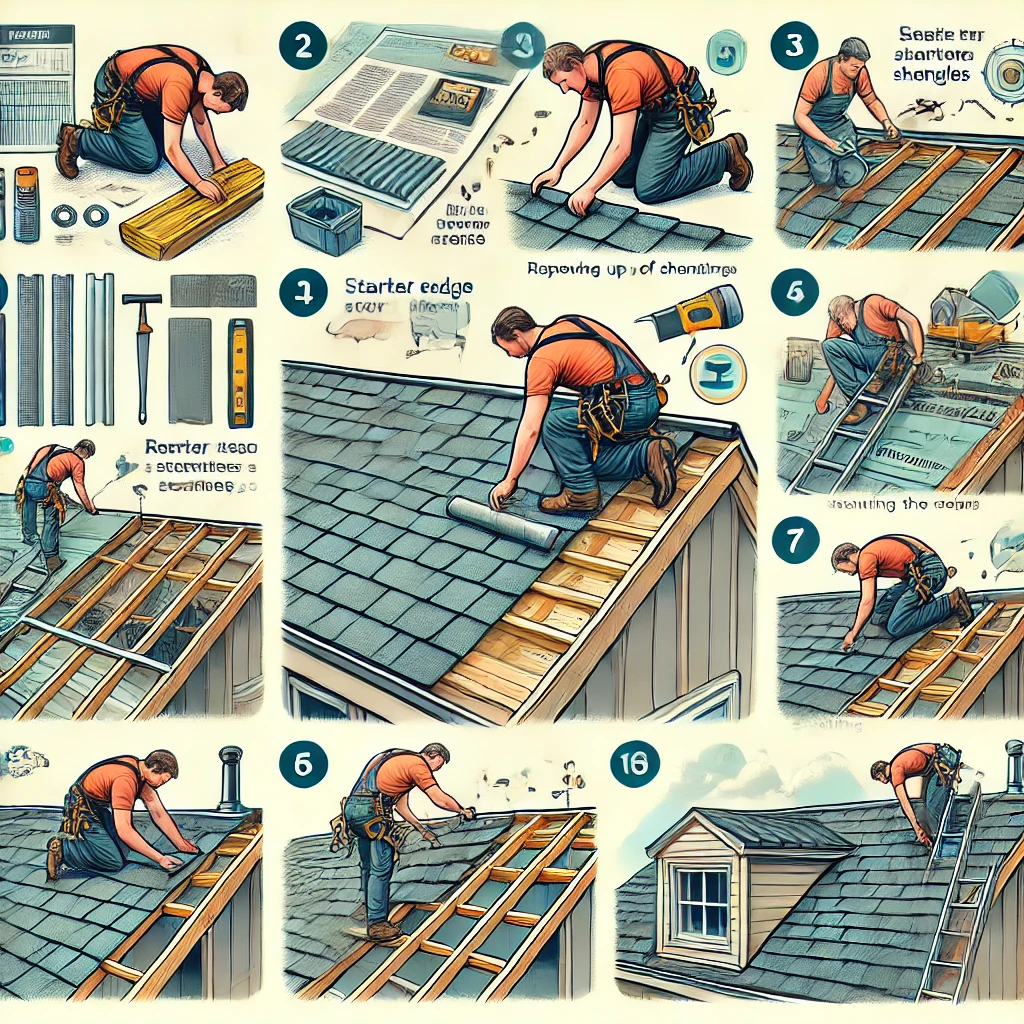Laying shingles on your roof can seem overwhelming, but with proper preparation and safety measures, it’s a manageable DIY project. It’s important to note that falls from roofs are a leading cause of construction-related fatalities, so ensuring safety is crucial. However, with the right tools and precautions in place, anyone can learn how to lay shingles effectively and safely.
Why Asphalt Shingles Are the Best Choice
Asphalt shingles are the most commonly used roofing material, and for good reason. They are affordable, durable, and typically last around 30 years, which is longer than most homeowners stay in their homes. These shingles are ideal for roofs with a pitch of at least 2/12 (two feet of rise for every twelve feet of run), but they perform best on roofs with a pitch of 4/12 or greater. Flat roofs are not suitable for laying shingles due to water drainage issues, as a lack of slope prevents proper water runoff.
Essential Materials for Laying Shingles
When laying shingles, roofing nails (typically 1 ¼” or 1 ½” in length) are required to secure the shingles and other roofing materials. Roofing nails have larger heads, which help prevent them from tearing through the shingles, especially in high winds. Proper installation is essential to ensure water flows downhill, with each shingle overlapping the one below it to prevent leaks.
Step-by-Step Guide on How to Lay Shingles

Roofing Safety First
Before beginning the process of laying shingles, safety should always be your first concern. Always use a safety line secured to the roof peak and a safety rail at the roof’s bottom edge. For steeper roofs, install roof jacks and planks to provide stable footing and prevent slips.
Preparing the Roof Surface
Whether you’re installing shingles on a new roof or re-roofing an existing one, it’s important to first prepare the roof surface. Check if the old shingles need to be removed, as some building codes allow up to three layers of shingles. If the existing roof is damaged or worn out, remove the old shingles using a pitchfork to pry them up. Inspect the roof sheathing for any water damage, especially around the edges and penetrations like vent pipes. Replace any damaged wood to ensure a solid foundation for the new shingles.
Installing Drip Edge, Flashing, and Felt
Drip Edge Installation
Before laying shingles, install drip edge along all edges of the roof. Drip edge is an aluminum strip that directs water off the roof, preventing it from soaking into the sheathing. Attach it to the roof, leaving a small gap between the drip edge and the fascia to allow for water drainage.
Flashing
Flashing is necessary at areas where roof sections meet or where there are roof penetrations, such as vents or chimneys. Flashing should be installed over a layer of ice and water protector to prevent leaks. Properly overlapping the flashing with the shingles is key to ensuring a watertight seal.
Roofing Felt
Once the roof is prepared, cover it with 30 lb. roofing felt, starting from the eaves and working upward. This extra waterproof layer will help prevent leaks. Overlap each course of felt by at least 3 inches to create a continuous barrier.
How to Lay Shingles: The Installation Process
Asphalt shingles are typically 12” x 36” with slits to form three smaller shingles. These shingles have a heat-activated adhesive at the bottom, which helps them bond to the one below when exposed to sunlight, preventing wind damage. When you lay shingles, be sure to secure each one with eight nails: four nails through the shingle and four nails through the shingle beneath it.
Starter Course
The first course of shingles, known as the starter course, is critical for proper alignment and water flow. You can buy starter shingles or cut regular 3-tab shingles to create them. Install the starter shingles, leaving a slight overhang beyond the drip edge to ensure water flows off the roof, not under it.
Laying Subsequent Shingles
When laying shingles, ensure that the seams between shingles are staggered to prevent water from seeping through. Each row of shingles should be offset by half a tab to create a consistent pattern. Use a utility knife to cut the shingles to the required length. Continue this process up the roof, ensuring proper overlap and alignment with each row.
Dealing with Roof Penetrations
Roof penetrations such as vents, skylights, and chimneys are familiar sources of leaks if not properly sealed. When laying shingles around these areas, use flashing and overlap the shingles on both sides to create a watertight seal. Be sure to embed the flashing in asphalt plastic cement for additional waterproofing.
Installing Ridge Caps
The final step is to install ridge caps, which are special shingles that cover the roof’s peak. Begin at the downwind end and work your way across, ensuring each ridge cap overlaps the one before it for optimal protection. Apply asphalt cement around the ridge cap edges for a secure seal.
Ridge Vent Installation
If your roof design includes a ridge vent, trim shingles around the vent opening and install the vent before continuing with the ridge caps. The ridge cap should be installed around the vent, leaving the vent open to allow for ventilation.
Conclusion: Successfully Laying Shingles on Your Roof
Learning how to lay shingles is a rewarding DIY project that can save money and extend the life of your roof. Following these steps, ensuring proper safety, and using quality materials, you can install a durable roof that will protect your home for decades. Remember, taking your time and being meticulous with each step will ensure your roof is both functional and aesthetically pleasing.




